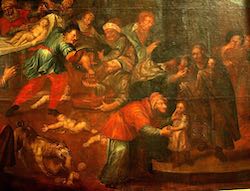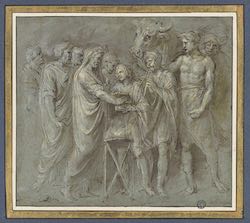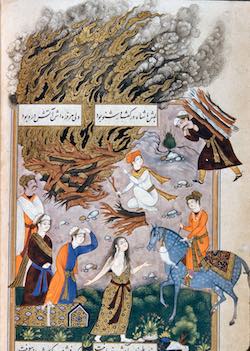Topic: 2. Sacrifice and religion: Comparisons, Antiquarians, Anthropology (16th-18th Century)
Religious sacrifices across various cultures and contexts sparked widespread interest in Early Modern Europe. As Christianity expanded into regions inhabited by "infidels" and "pagans", Europeans encountered a diverse array of sacrificial customs, ranging from the Sati rituals in India to the Aztec sacrifices in the Americas. This cross-cultural exposure captivated a wide audience, including theologians, philosophers, political thinkers, antiquarians, orientalists, missionaries, poets, artists, and even the general public. These encounters broadened the European understanding of sacrifice and led to a critical reassessment of classical and biblical sacrificial rites. This section includes:
- Sources: A selection of early modern printed materials, which include descriptions of the Americas, Asia, and Africa, alongside antiquarian and philological studies on religious sacrifice in classical antiquity and beyond. It also presents early modern works of ethnological observations and the first attempts to compare different sacrificial practices in various traditions and contexts, laying the groundwork for disciplines like the history of religions and anthropology.
- Iconographic Representations: A rich collection of images from the 16th to 18th centuries, illustrating a range of sacrificial rituals and practices as seen in different cultural and geographical contexts.
- Related Bibliography: An extensive bibliography spanning scholarly works from the 19th to 21st centuries, providing contemporary analyses and interpretations of these early studies and observations.
Sacrifice In The Rgveda (Its Nature, Influence, Origin and Growth)
Bombay: Bharatiya Vidya Bhavan, 1953.
Human sacrifices in India : substance of the speech of John Poynder
London: Hatchard and Son, 1827.
A Comparison of the Institutions of Moses with Those of the Hindoos and Other Ancient Nations
Northumberland: Kennedy, 1799.
Dokumenti za katolicheskata deĭnost v Bŭlgarii͡a prez XVII vek.
Sofia: Universitetsko izd-vo Sv. Kliment Okhridski, 1993.
An Historical and Geographical Description of Formosa
Amsterdam: Roger, 1704.
To Become a God: Cosmology, Sacrifice , and Self-Divinization in Early China
Cambridge, Mass.: arvard University Asia Center,, 2002.
The work of appropriation, domestication, and substitution: theories of sacrifice in the Liji
in: All about the Rites: From Canonised Ritual to Ritualised Society, pp. open access
Paris : Collège de France, 2023.
Rituals of death: capital punishment and human sacrifice
in: Facing the death penalty, pp. 139–155
Philadelphia: Temple University Press, 1989.
2. Sacrifice and religion: Comparisons, Antiquarians, Anthropology (16th-18th Century) 3. Sacrifice and politics (16th-18th Century)
The sacrifice of the Feast of Tabernacles (1746)
from: Histoire universelle, depuis le commencement du monde, jusqu’à présent, Volume 7, published Amsterdam: Arkstée et Merkus, 1742-1782.
Lowcountry Digital Library, College of Charleston Libraries
Satī, from a Sūz u Gudāz manuscript. The pyre; the bride preparing to sacrifice herself (1650)
from: Nawʻi Khabushani, Muhammad Riz̤a, Sūz u Gudāz, fol. 31v
Chester Betty Library, Dublin, Ireland MS Pers 268, fol. 31b
Ritual and Sacrifice in the Ancient Near East
Leuven: Peeters, 1993.
Uno stereotipo antigiudaico per immagini
in: Il Simonino. Geografia di un culto.Con saggi di Diego Quaglioni e Laura Dal Prà , pp. 9-16
Trento: Società di Studi Trentini di Scienze Storiche, 2012.
Collecting Cultures: A Mexican Manuscript in the Vatican Library
in: Reframing the Renaissance: Visual Culture in Europe and Latin America, 1450–1650, pp. 228-242
New Have, CT: Yale University Press, 1995.




